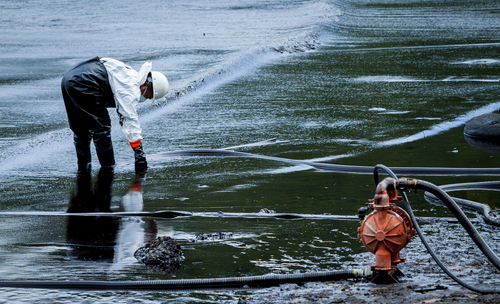At-Sea Spills: Importance of Contingency Planning

Significant oil spills can remain in the press and the social consciousness for years or even decades. The damage done by major events like the Exxon Valdez spill and the Deepwater Horizon well blowout increase and reinforce to Owners and Operators that in the event of a spill they need to respond immediately, communicate effectively and publicly and resolve the incident rapidly. This includes working with stakeholders at the local, regional, and national level in an effort to minimize injury to the environment. In some cases, not all of your response goals can be met, but you can improve response efficiency, both in time and cost, and validate the importance placed on the environment by your organization, by having oil spill contingency plans and response techniques already institutionalized at your company. This planning starts with USCG-approved Vessel Response Plans (VRP).
The U.S. Coast Guard regulations addressing oil spill vessel response plans for tank vessels and non-tank vessels can be found at Title 33, CFR, part 155 – Oil and Hazardous Material Pollution Regulations for Vessels. Tank vessels calling the United States that carry oil in bulk as cargo or oil cargo residue must have a Vessel Response Plan (VRP) approved by the U.S. Coast Guard (USCG); if a foreign vessel, approval must be received before the vessel can enter U.S. waters. Non-tank self-propelled vessels that are larger than 400 GT and are calling the United States must have a Non-tank Vessel Response Plan (NTVRP) approved by the U.S. Coast Guard (USCG) before the vessel can enter U.S. waters. In general, the VRP requirements include:
- General Information and introduction
- Notification Procedures – Statutory notifications and Internal notifications
- Shipboard Spill mitigation procedures
- Shore-based response activities
- List of all relevant contacts including Q.I., OSRO, Salvor, Firefighter, etc. in order to establish a communication network that will coordinate your spill response
- Further training and exercise procedures
- Geographic-specific appendix for each COTP zone
An oil spill contingency plan is a detailed oil spill response and removal plan that addresses controlling, containing, and recovering an oil discharge in quantities that may be harmful to navigable waters or adjoining shorelines. As you draft your contingency plans, you need to consider several critical factors.
- Marine life—sensitive or important physical and biological resources in or near the sea, including marshes, unusual plants, and wildlife
- Habitats—environments required by various species for spawning, feeding or migration
- Climate, weather pattern and tides
- Shoreline characteristics
- Proximity to roads, airports and other transportation-support provisions
You have got to be able to get responders and supplies in and out of the area with as minimal disruption to the natural surroundings as possible. If you have a plan that has been thought through (not just copied from the Internet or a manual) and you have tested it in simulation, you will be much less likely to stumble and bumble in a real-life at-sea oil spill.
Conducting an Actual Response
From an International perspective, the International Tanker Owners Pollution Federation has provided the U.N. Environment Program a nice summary regarding two kinds of marine pollution incident response. The first has to do with enhancing natural dispersion of spilled oil. The second deals with containment and recovery of the oil.
Although natural dispersion of smaller spills can be assisted with dispersant chemicals, there are factors that mitigate this method’s effectiveness and appeal. For example, some types of oil respond poorly to dispersants, especially oils with high viscosity and lighter oils that become more viscous due to weather or emulsification with water, sometimes after just a few hours. If a spill covers a large area, you will need special equipment and extensive logistical support to apply the dispersant, the U.N. warns. In the U.S., dispersant use is a rarity and requires explicit approval of the Environmental Protection Agency (EPA) and U.S.C.G. The U.S. EPA states that generally, the use of dispersants is restricted under the National Oil and Hazardous Substances Pollution Contingency Plan (NCP). Dispersants must be on the U.S. EPA Product List, and federal and state agencies have agreements establishing areas where rapid decisions on dispersants may be made by the Federal On-Scene Coordinators. Areas outside those with designated agreements are required to get additional approval from agencies identified in the NCP.
Containment and recovery, using oil booms and skimmers for instance, may be preferable to prevent damage to surrounding areas and animal life. These efforts are often hampered, however, by weather and sea conditions. The fairly small encounter rate with oil that recovery systems can achieve also reduces the effectiveness of containment and recovery.
Burning at the spill site and the introduction of microorganisms or nutrients that speed natural biodegradation of the oil are two alternative techniques currently being studied.
In our next article, we’ll discuss what you can expect in terms of threats to coastal resources since, even using both of these at-sea responses, you will likely be able to deal with only a small fraction of a large marine oil spill. WQIS is the leader in the vessel pollution insurance market offering the most comprehensive coverage, the most experienced underwriting and claims department with the most effective response team in the market. To learn more about our products and services, call us at 212-292-8700.
